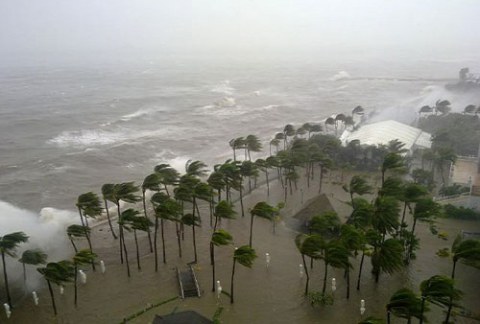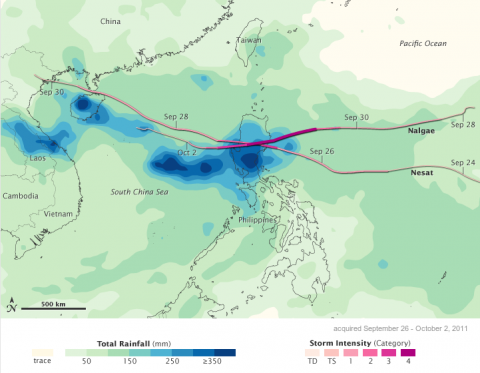Filipinos are fighting for survival amid worsening climate change according to the Philippine delegation to the United Nations Framework Convention on Climate Change (UNFCCC) round of talks in Panama. The main island of Luzon and the national capital Manila have been blasted and battered in late September and into early October by two consecutive typhoons which have killed at least 76 people and caused at least US$200 million in damage to infrastructure and agriculture.
"Millions of Filipinos are already suffering yet we are only seeing initial climate change impacts. Progress must be made in the climate treaty negotiations," said Commissioner Naderev “Yeb" Saño of the Climate Change Commission (CCC) in a media statement. "We are here in Panama to tell the world that climate change is a matter of life and death for the Philippines," Saño said.
The Panama Climate Change Conference runs from October 1 to 7, and is expected to set the tone for the Durban Conference of the Parties - COP17 - to be held in South Africa from 28 November - 9 December 2011.
The Philippines delegation is pushing for major progress concerning the future of the Kyoto Protocol, with the first commitment period due to expire in 2012. It is the only signed climate agreement which mandates emissions reductions from industrialised countries. The United States, the world's largest historical emitter of greenhouse gases, remains the only nation to reject the Kyoto Protocol, although during 2010 Canada, Japan, and Russia announced their withdrawal from the Kyoto Protocol.
The Philippines was instrumental in the adoption of the Protocol in 1997, while Australia did not sign until 2007 shortly before the Bali conference. At present there is no clear new agreement in sight with the Copenhagen protocol being a purely voluntary listing of each country's emission reduction aspirations which falls far short of the reductions needed for a reasonable chance to prevent global climate catastrophe. (See the Global Emissions Gap Scoreboard)
Twin typhoons batter Luzon

The Philippines experiences on average 19 tropical cyclones or typhoons each year of which some 6-9 usually make landfall. The two typhoons that struck the Island of Luzon were the Category 3 typhoon Nesat (Pedring), followed by Category 4 super typhoon Typhoon Nalgae (Quiel). Early on September 27, Typhoon Nesat struck the Philippines with a maximum 1-min sustained wind speed of 105 knots (194 km/h; 121 mph). Fifty five people have been confirmed dead and 2 missing, with destruction to infrastructure and agricultural crops an estimated US$200 million in damage. Storm surge and river flooding caused major disruptions cutting power and halting daily activity in Manila and other cities and towns. The typhoon was reported to have sent surging waves as tall as palm trees over seawalls completely submerging neighborhoods. The Philippine Stock Exchange and US embassy were both forced to close due to the strong winds, heavy rains and flooding of streets.
With many of the dams at bursting point, waters were released exacerbating the flooding. The PAGASA weather bureau chief Graciano Yumul said "You can look at all the scientific computations and we can really prove that the dam openings would only contribute a maximum of 5% to the floods we see now in Pampanga and Bulacan. The water came from the run-off from the mountains, due to rains dropped by Pedring,"
On October 1st the second storm hit - Category 4 super typhoon Typhoon Nalgae (Quiel) following an almost identical track to the first storm. With the ground already saturated and floodwaters still present Nalgae continued to worsen the flooding and destruction brought by Nesat.
According to NASA, "Several months worth of rain fell within a week — a deluge even by tropical standards — on Luzon in the northern Philippines, as well as in northern Vietnam and the Chinese island of Hainan."
About 2.85 million people have been directly affected by Nesat (Pedring) in several provinces including Metro Manila. A further 77,000 people were affected by Nalgae (Quiel). Both typhoons damaged more than 51,000 houses nationwide according to a report in the Philippine Star - Combined death toll from 'Pedring,' 'Quiel' rises to 76. More than 300,000 people were being housed in evacuation centers, and damage estimates were approaching 8.8 billion pesos ($200 million U.S.).
In January this year La Niña brought torrential rain, floods to Philippines killing 42.
Sea Level Rise in the Philippines
The WWF highlighted that the IPCC 4th Assessment Report found that the Philippines was vulnerable to climate change with:
- Increase in mean annual, maximum and minimum temperatures by 0.14°C between 1971-2000. Increase in annual mean rainfall since 1980s and in number of rainy days since 1990s
- Increased occurrence of landslides and floods in 1990 and 2004
- On average 20 cyclones cross the Philippines Area of Responsibility (PAR) with about 8-9 making land fall each year; with an increase of 4.2 in the frequency of cyclones entering PAR during the period 1990-2003
- Decrease of rice yield associated with increase of temperature (0.35 °C and 1.13°C for maximum and minimum respectively during 1979-2003)
Being an island nation sea level rise will impact many low lying populated and agricultural areas of the Philippines. The large storm surges of typhoons Nesat (Pedring) and Nalgae (Quiel) and the widespread flooding that followed is an indicator of what global warming has in store for developed and developing countries alike. Of 16 regions in the Philippines, only one is not vulnerable to sea level rise. The mountainous
Cordillera Administrative Region, is instead highly at risk from typhoons, mudslides and variability in precipitation.
The marine ecosystem around the Philippines, which many local communities depend upon for fishing, is also under threat. Changes to atmospheric temperatures has brought irregular monsoon and extreme weather events that impact the fisheries. Increased Sea Surface Temperatures (SSTs) has resulted in coral bleaching events reducing the live coral on Philippine reefs which will impact species diversity.
A 2007 Greenpeace report - The Philippines: A Climate Hotspot Climate Change Impacts and the Philippines - said that with "a one-meter rise in sea level, it is projected to affect 16 regions, 64 out of 81 provinces (Appendix 3), covering at least 703 out of 1,610 municipalities, inundating almost 700 million square meters of land and potentially displacing at least 1.5 million Filipinos".
"Provinces that are highly vulnerable to a one meter sea level rise (Table 1) include Sulu (Figure 3), the land of treasures and farers of the sea (79,728,300 square meters); Palawan which is considered as the Philippines’ last frontier (64,281,600 square meters); and the culturally-rich province of Zamboaga del Sur (37,817,900 square meters). At least 90% of the land area of the Municipality of Pata and 34% of the Municipality of Marunggas, both in the province of Sulu, are at threat, potentially displacing communities, damaging infrastructure, and affecting livelihood." said the report.
"Ironically, the regions that are highly vulnerable to a one meter rise in sea level (Table 2), such as the Autonomous Region of Muslim Mindanao (ARMM), the Zamboanga Peninsula (Region 9), Eastern Visayas (Region 8) and the Bicol Region (Region 5) are also areas that have the highest Poverty Incidence in the Philippines."
In conjunction with sea water rise many populated areas around Manila Bay are subject to ground subsidence attributed to groundwater extraction. "An increase in sea level will accelerate and worsen flooding in the northwest delta plain of Manila Bay which is already experiencing subsidence at an alarming rate of at least three centimeters a year due to groundwater extraction. This situation is similar in key cities such as Legazpi City, Davao City, and Jolo which are experiencing subsidence at a rate of 5.9mm per year, 3.2mm per year, and 0.4mm per year, respectively." said the Greenpeace report.
"There is so much fuss about sea level rise but not much attention to land subsidence. We have sea level rise due to global warming and it is rising at 2 millimeters per year. We're so concerned about it but the land is subsiding at 5.5 centimeters per year," said Dr. Mahar Lagmay of the UP National Institute of Geological Sciences in a June 2011 report on ABS-CBN news.com - UP NIGS: Too much fuss about sea level rise....
"Some parts of Bulacan like Calumpit are subsiding. We measured the subsidence at 3.4 to 4 cm per year. The largest ones are found in Meycauayan and Marilao in Bulacan, up to 5.5 cm per year," he said. "Dikes are part of the land. When the land sinks, the dike sinks too." He said that much of the over extraction of ground water from deepwells is used by aquaculture and agriculture.
This is the injustice of climate change and sea level rise - it impacts the most those who have contributed the least to the problem while affecting them the most, with the least ability to find ways to adapt to the changing climate and a rising sea level.
The report concludes arguing for a pro-active climate change adaptation policy framework for the Philippines as well as a reformulation of its energy policy reducing its dependence on fossil fuels, particularly coal and coal fired power stations, and embrace renewable energy and energy efficiency to cut carbon dioxide emissions by as much as 30% by 2050. "From a moral, legal and practical perspective, the initial burden of emissions reductions has to fall on industrialized countries. However, developing countries like the Philippines must also immediately stabilize their carbon dioxide emissions even as developed countries must make drastic cuts." says the report.
The Philippines is dependent on at least 9 coal-fired power plants in the country – six in Luzon Island, two in the Visayas in central Philippines and one in Mindanao in the southern Philippines. Energy companies are eager to build more but face active opposition from environment groups citing the contribution in greenhouse emissions they make to global warming and the potential for renewable energy development.
You can read about Climate Change: The Philippine Response at the Presidential Task Force on Climate Change website.
Sources:
- Wikipedia, Typhoons in the Philippines
- Wikipedia, Typhoon Nesat (2011) aka Pedring
- Wikipedia, Typhoon Nalgae (2011) aka Quiel
- NASA Earth Observatory, Typhoons Nesat and Nalgae Soak The Philippines
- NASA Earth Observatory, Typhoon Nesat
- Philipine Star - Combined death toll from 'Pedring,' 'Quiel' rises to 76
- Media Statement from Panama City, October 5, 2011, Pinoy Climate Team in battle for PHL survival as climate talks open in Panama
- ABS CBN News, October 2, 2011, Storm signals lowered as 'Quiel' moves away from PH
- Greenpeace report, April 2007 - The Philippines: A Climate Hotspot (PDF) Climate Change Impacts and the Philippines
- Image - Storm Surge from Sofitel Philippine Plaza during Typhoon Nesat by Amckern from Wikimedia Commons. Creative Commons CC-by-SA 3.0
- Image coutesy NASA Earth Observatory, Typhoons Nesat and Nalgae Soak The Philippines


